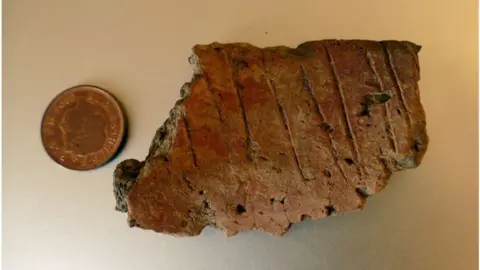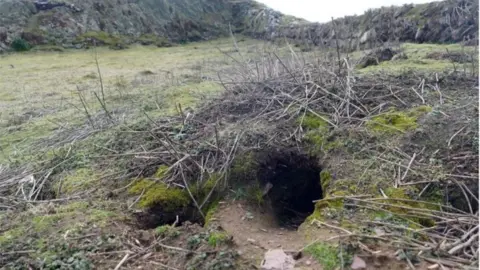Skokholm Island: Prehistoric tool found down rabbit hole
 Richard Brown and Giselle Eagle
Richard Brown and Giselle EagleA prehistoric stone age tool that dates back 9,000 years was found by chance down a rabbit hole.
The bevelled pebble could have been used for preparing seal hides to make watercraft or for processing shellfish.
It was found by wardens on Skokholm Island, off Pembrokeshire, earlier this month.
But the discoveries did not end there - the very next day, a 3,750-year-old burial urn, kicked out of the same rabbit hole, was found.
With no visitors currently allowed, wardens have been the only people wandering around the island, two miles off Pembrokeshire, famed for its tens of thousands of nesting seabirds.
Nearby Skomer had always been better known for its well-preserved prehistoric archaeology, but the finds by wardens Richard Brown and Giselle Eagle have changed that.
Photographs of the smooth rectangular stone were sent to prehistoric stone tool expert Dr Andrew David.
 Bob Embleton / Geograph
Bob Embleton / GeographHe said: "The photos were clearly of a late-Mesolithic (Middle Stone Age) 'bevelled pebble', a tool thought to have been used in tasks like the preparation of seal hides for making skin-clad watercraft, or for processing foods such as shellfish, among hunter-gatherer communities some 6,000 to 9,000 years ago.
"Although these types of tools are well known on coastal sites on mainland Pembrokeshire and Cornwall, as well into Scotland and northern France, this is the first example from Skokholm, and the first firm evidence for Late Mesolithic occupation on the island."
The day after finding the bevelled pebble, the wardens noticed large pieces of coarse pottery that had been kicked out of the same rabbit hole.
 Richard Brown and Giselle Eagle
Richard Brown and Giselle EagleNational Museum Wales archaeology curator Jody Deacon recognised it as a large fragment from a thick-walled pot, usually associated with cremation burials.
It is about 3,750 years old, and while such urns are not unusual in west Wales, it was the first of its type to be found on Skokholm Island.
Archaeological surveys have previously taken place on the nearby islands of Skomer, Grassholm and Ramsey, and there are now plans for one on Skokholm later in 2021, when Covid restrictions allow.
 Richard Brown and Giselle Eagle
Richard Brown and Giselle Eagle"We know from past aerial surveys and airborne laser scanning by the Royal Commission that Skokholm has the remains of some prehistoric fields and settlements, though none has ever been excavated," said archaeologist Toby Driver.
"Now Skokholm is producing some amazing prehistoric finds. It seems we may have an Early Bronze burial mound built over a Middle Stone Age hunter gatherer site, disturbed by rabbits. It's a sheltered spot, where the island's cottage now stands, and has clearly been settled for millennia."
